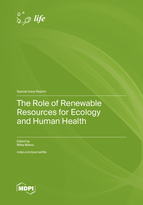The Role of Renewable Resources for Ecology and Human Health
A special issue of Life (ISSN 2075-1729). This special issue belongs to the section "Plant Science".
Deadline for manuscript submissions: closed (20 December 2022) | Viewed by 24414
Special Issue Editor
Interests: antioxidant activity; oxidative stress; free radicals; virus; antioxidants; biotechnology; biostatistics; cancer research; reactive oxygen species; biomarkers
Special Issues, Collections and Topics in MDPI journals
Special Issue Information
Dear Colleagues,
Recently, numerous studies have focused their attention on natural bioactive compounds, which have been proven to play a potentially beneficial role in the fight against a wide range of human diseases, from "modern" metabolic disorders, chronic diseases, neurodegenerative diseases, cancer, and cardiovascular disease, to resistant pathogens, bacteria, viruses, and fungi, whose higher resistance to conventional drugs is a very serious problem for human health.
It turns out that the source of valuable molecules is often products that are considered to be waste in technological production or agricultural byproducts which are discarded without being recovered. Thus, a large number of these natural functional ingredients still remain unused, and a clear understanding of the mechanisms of their beneficial properties needs innovative and original research.
Potential topics in this issue include but are not limited to the following:
- Useful and original approaches for the utilization of residual and waste products from technological productions and agricultural activity;
- Preparation, isolation, identification, and examination of natural extracts or synthetic drugs that are modified analogs of natural biomolecules with valuable biological properties;
- Formulation and delivery of anti-inflammatory, antiviral, antifungal compounds with high stability and good bioavailability in order to potentiate their activity;
- Exploration of the putative activity in the cascade of events controlling the development of disease;
- In vivo and in vitro screening, which involves specific compounds to identify them as new, leading compounds, with the potential to cause relief of symptoms and to influence the progression of the disease.
We kindly invite you to send your latest research results or review articles to this Special Issue, which will clarify the biological effects of your research waste products, natural compounds, and demonstrate the mechanisms underlying their biological activity, using various experimental models related to the extraction and purification of natural functional components and their application, the presence of hazardous substances, and useful properties of these extracts or compounds in various diseases. Please note that in the studies of complex mixtures of natural products or newly synthesized substances, the characterization of chemicals using analytical methodologies such as HPLC, MS, LC-MS, and HPLC-MS must be included.
Dr. Milka Mileva
Guest Editor
Manuscript Submission Information
Manuscripts should be submitted online at www.mdpi.com by registering and logging in to this website. Once you are registered, click here to go to the submission form. Manuscripts can be submitted until the deadline. All submissions that pass pre-check are peer-reviewed. Accepted papers will be published continuously in the journal (as soon as accepted) and will be listed together on the special issue website. Research articles, review articles as well as short communications are invited. For planned papers, a title and short abstract (about 100 words) can be sent to the Editorial Office for announcement on this website.
Submitted manuscripts should not have been published previously, nor be under consideration for publication elsewhere (except conference proceedings papers). All manuscripts are thoroughly refereed through a single-blind peer-review process. A guide for authors and other relevant information for submission of manuscripts is available on the Instructions for Authors page. Life is an international peer-reviewed open access monthly journal published by MDPI.
Please visit the Instructions for Authors page before submitting a manuscript. The Article Processing Charge (APC) for publication in this open access journal is 2600 CHF (Swiss Francs). Submitted papers should be well formatted and use good English. Authors may use MDPI's English editing service prior to publication or during author revisions.
Keywords
- residual products
- waste products
- multidrug resistance
- cancer
- natural compounds and antioxidants
- anti-inflammatory effect
- antiviral properties
- antifungal activity







